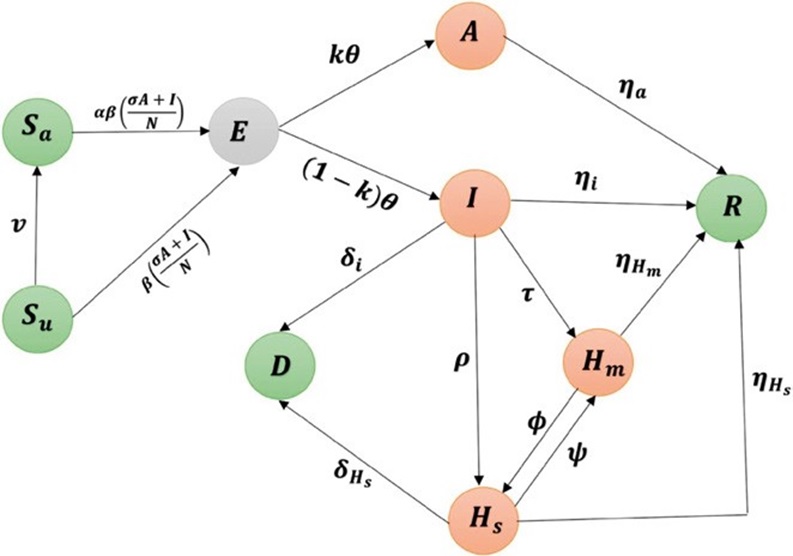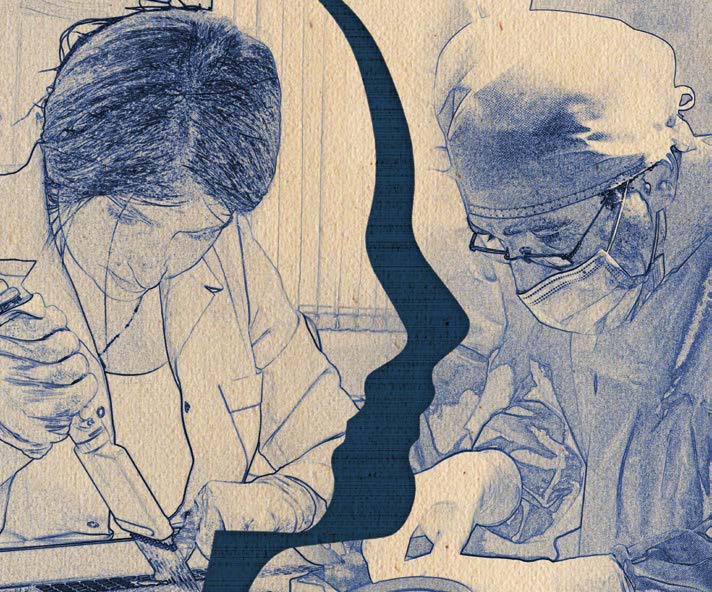Ֆիզիկական մոդելների կիրառումը կանխարգելիչ բժշկության մեջ.
Լևոն Ա. Թադևոսյան, Տիգրան Տ. Հովհաննիսյան
Հայ-ռուսական համալսարան, Երևան, Հայաստան
ԱՄՓՈՓԱԳԻՐ
Երբ խոսքը վերաբերում է բժշկության մեջ գրաֆիկների կառուցմանը՝ մաթեմատիկական և ֆիզիկական մոդելները մեծ ներուժ ունեն: Այս հոդվածում ամփոփվել են տարբեր հոդվածների արդյունքները, որոնք վերաբերում են կանխարգելիչ բժշկության մաթեմատիկական և ֆիզիկական մոդելներին:
Ուսումնասիրվել են A տիպի H1N1 գրիպի, ինչպես նաև SARS-Cov 19-ի մոդելները և ներկայացվել ու վերլուծվել են այլ հեղինակների կողմից առաջարկված մոդելները:
Հիմնաբառեր. կանխարգելիչ բժշկություն, ֆունկցիա, COVID-19
DOI:10.54235/27382737-2022.v2.1-38
INTRODUCTION
Preventive Medicine, or prophylaxis, consists of measures taken for disease prevention. Disease and disability are affected by environmental factors, genetic predisposition, disease agents, and lifestyle choices, and are dynamic processes which begin before individuals realize they are affected. Disease prevention relies on anticipatory actions that can be categorized as primary, secondary, and tertiary prevention [1-3].
- Primary: Primary prevention aims to prevent disease or injury before it ever occurs. This is done by adopting legislative changes such as the ban of the use of hazardous products, mandatory health practices, etc.
- Secondary: Secondary prevention aims to reduce the impact of a disease or injury that has already occurred. This is done by finding and treating the disease in an early stage. Good example of secondary prevention is cancer screenings.
- Tertiary: Tertiary prevention aims to soften the impact of an ongoing illness or injury that has lasting effects. This is done by helping people manage long-term and complex health problems and injuries [4].
MODEL 1: H1N1 INFLUENZA A
The H1N1 influenza A virus caused a pandemic in 2009 that affected people all over the world. This virus was unique because it was a combination of human, swine, and avian viruses. It is thought that this virus developed when humans came into contact with pigs. The virus was firstly recognized at the border between Mexico and the United States in April 2009. The H1N1 virus caused a lot of illness and death, and the global health system had to scramble to respond to it.
The 2009 flu outbreak was referred to as “swine influenza” or H1N1 influenza A. The swine flu virus is actually a genetic mixture of two strains, both found in swine, of unknown origin. All the genes in the pandemic strain of 2009 came from the socalled “swine triple-reassortant flu” (T-RV) that has been circulating in pigs since at least 1999.
Swine influenza viruses are normally found only in pigs and do not infect humans. However, human infections with swine flu do occur, and these have been increasing over the past few years. Most human infections have occurred in people who were exposed to infected pigs, such as farmers or veterinarians. Most of the swine-to-human transmissions were not transmitted further than 1 person and were dead ends. Nevertheless, a small number of cases of human-to-human transmission of swine flu have been documented since 2005. Furthermore, human-to-human transmissions have been documented since the late 1950s, but in very scarce and small numbers.
The symptoms of swine flu in humans are similar to the symptoms of regular human seasonal influenza and include fever, cough, sore throat, runny nose, body aches and fatigue. In addition, nausea, vomiting and diarrhea have also been reported.
The Centers for Disease Control and Prevention recommend real-time polymerase chain reaction as the method of choice for diagnosing H1N1 swine flu in humans. Treatment for swine flu is the same as treatment for regular human seasonal influenza and includes rest, plenty of fluids and fever-reducing medication such as acetaminophen or ibuprofen. Antiviral drugs are also recommended for treatment of swine flu in people who are hospitalized, have severe illness or are at high risk for complications from influenza.
The best way to prevent swine flu is to get vaccinated against it. There are two types of vaccines available for swine flu: inactivated (killed) vaccine and live attenuated (weakened) vaccine.
Inactivated vaccines are given by injection and are recommended for people over the age of six months.
MODEL 2 SARS-COV 19
SARS-CoV-2: the virus that causes a respiratory disease called coronavirus disease 19 (COVID-19). SARS-CoV-2 is a member of a large family of viruses called coronaviruses. These viruses are transmitted amongst humans and can as well be transmitted from humans to animals.
The first documented case of SARS-CoV-2 among humans was in 2019. Infection with SARS-CoV-2 can cause a range of respiratory illnesses from the common cold to more serious diseases such as pneumonia. The symptoms of COVID-19 include fever, coughing and difficulty breathing. In severe cases, the infection can lead to death.
Research is being done to treat COVID-19 and to prevent infection with SARS-CoV-2, also called severe acute respiratory syndrome coronavirus [5]. Public health and social measures (PHSMs) are being implemented across the globe to suppress SARS-CoV-2 transmission and reduce mortality and morbidity from COVID-19. PHSMs include, but are not limited to, physical distancing (e.g. canceling mass gatherings and working from home), wearing of face masks in public settings, self-quarantine after travel, hand hygiene, and surface decontamination.
Figure 1 represents the statistical graph with all the cases from March 2020 to May 2021 concerning the COVID-19 situation in Armenia.
However, when determining the dynamics of the transmission of COVID-19 has been one of the highest rates and the compartmental model provides more insights. The outbreak has been declared a pandemic by the World Health Organization. As of June 2019, there have been more than 80 000 cases and over 3000 deaths reported in more than 30 countries. Several methods are used to determine and outline the dynamics. For the purpose of this paper we took and examined methods that rely on statistics of COVID-19 cases before the development of the vaccine [6].

Fig. 1. Weekly incidence of COVID-19 in Armenia, March 2020 May 2021.
The graph shown in figure 1 has function that has the following look:
y = acos(kx) + bsin(dx)
where a, b, k and d are constants, x is the number of days and y is the number of cases. The above equation is the physical equation. On the contrary, epidemiologists use the comportamental which is applied to the mathematical modeling of infectious diseases. The physics function model does not contain the variables and parameters common for the compartmental model (susceptible, infectious, carrier etc.). The function provides the overview over the new daily cases and increases over the dynamics.

Variable Description
N Total human population
Sa Aware susceptible individuals
Su Unaware susceptible individuals
E Exposed individuals, those who are in the latent period
A Asymptomatically infectious individuals
Im Symptomatically infectious individuals
Hm Hospitalized/isolated individuals with mild symptoms
Hs Hospitalized/isolated individuals with severe symptoms
R Recovered humans
D Deceased humans
Parameter
β Community transmission or successful contact rate
α Modification parameter for decrease on infectiousness in Sa
σ Infectiousness factor for asymptomatic individuals
v Rate at which unaware susceptible will become aware about the disease θ Progression rate
k Fraction of infections that become asymptomatic
τ(ρ) Hospitalization rates from I to Hm (Hs)
ψ Rate at which the hospitalized individuals move from mild to severe isolation φ Rate at which the hospitalized individuals move from severe to mild isolation δj(j=i,Hs) COVID-19 induced death rates
ηl(k=a,i,Hs) Recovery rates
Fig. 2.
The graph provided in figure 2 is based on a deterministic model and taking the regular SEIR model (a compartmental model used in epidemiology) to outline the virulence of the COVID-19 disease. The variables and parameters of the graph shown in figure 2 are as in table 1. The green color represents non-infected individuals, gray exposed ones and pink the infected.
The following models can be utilized to analyze the disease-free equilibriums to determine the effectiveness of the actions of the preventive medicine. Moreover, the effect the vaccine has on the prevention of the spread of COVID-19 can also be determined with the SEIR model [6].
REFERENCES
- Hugh R. Leavell and E. Gurney Clark as “the science and art of preventing disease, prolonging life, and promoting physical and mental health and efficiency. Leavell, H. R., & Clark, E. G. (1979). Preventive Medicine for the Doctor in his Community (3rd ed.).
- Huntington, NY: Robert E. Krieger Publishing Company.
- “New parents” secure a lifelong well-being for their offspring by refusing to be victims of societal stress during its primal period”. Primal Prevention.
- “Primal Health Research Databank Glossary’’. primalhealthresearch.com. Retrieved 2021-07-05.
- “At Work”, Issue 80, Spring 2015: Institute for Work & Health, Toronto
- “NCI Dictionary” National Cancer Institute
- Musa SS, Qureshi S, Zhao S et al. Mathematical modeling of COVID-19 epidemic with effect of awareness programs. Infect Dis Model 2021;6:448-460

